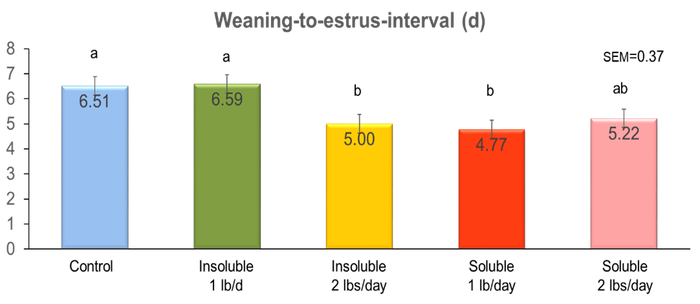Can short-term fiber supplementation improve farrowing?
Fiber has been associated with a reduction of stillborn pigs which may be explained by a potential decrease in farrowing duration.
November 2, 2023
.jpg?width=850&auto=webp&quality=95&format=jpg&disable=upscale)
By Gaby Martinez, CSA Animal Nutrition, Suzanne Leonard and Eric van Heugten, North Carolina State University, and David Rosero, Iowa State University
Sows undergo significant metabolic changes when they transition from gestation to the farrowing process. Targeted nutritional strategies can support sows during this transition period leading to improved reproductive performance.
In our research, we focused on the practical supplementation of fiber prior and during the farrowing process. Fiber has been associated with a reduction of stillborn pigs which may be explained by a potential decrease in farrowing duration (Feyera et al., 2017) and may possibly improve piglet vitality at birth. In addition, an increase in lactation feed intake has been observed when sows received high fiber in the diets during gestation (Sun et al., 2014) which is closely related with increased litter weaning weights (Che et al., 2011). However, the impact of fiber depends on the type of fiber implemented (soluble versus insoluble) and could potentially depend on the timing of supplementation.
We conducted a study to evaluate the impact of level and solubility of dietary fiber on sow and litter performance when fed during late gestation and during the pre-farrowing period. Sows (n= 241) were assigned a total of five dietary treatments, which consisted of a control diet without supplementation and supplementation of either 1 or 2 pounds per day of a fiber supplement that was added in addition to the regular feed (top-dress).
The fiber supplement was formulated to contain either a high concentration of soluble dietary fiber or a high concentration of insoluble dietary fiber. The top-dress supplements were formulated to meet target fiber levels using primarily sugar beet pulp and soybean hulls.
Sows began their dietary treatments on day 99 of gestation and continued to receive their treatments when they were transferred into the farrowing house at approximately 112 days of gestation until parturition. The farrowing process was monitored with video equipment as a pilot study to evaluate fetal expulsion length and piglet vitality index. PVI followed a 4-point scale consisting of 0 = no movement and no breathing, 1 = no movement, but the pig is attempting to breathe, 2 = moving and attempting to breathe or coughing, and 3 = good movement, pig is breathing and able to stand within 1 minute or less after being born. Reproductive performance data were collected at farrowing and at weaning.
Fiber solubility and level of supplementation did not affect the number of pigs born, piglet birth weight or weaning weight. Insoluble fiber supplemented at 1 lb/day reduced the number of stillborn pigs per litter, but increased the number of low-birth weight pigs (pigs weighing less than 2.2 lbs) and increased the number of non-viable pigs at weaning (pigs weighing less than 8 lbs).
In contrast, insoluble fiber supplemented at 2 lbs/day produced the highest number of stillborn pigs, but sows fed this treatment were able to produce quality litters at weaning by having the lowest number of non-viable pigs at weaning.
Soluble fiber, irrespective of the level of supplementation, did not influence the number of stillborn pigs or piglet weight at birth, but had a lower number of non-viable pigs at weaning compared to the control treatment. Weaning-to-estrus interval was positively affected by soluble fiber supplementation and by insoluble fiber when supplemented at 2 lbs/day (Figure 1).

Figure 1. Impact of fiber supplementation level and fiber type on weaning-to-estrus interval.
Our study monitored the farrowing process in select sows. We analyzed the data as a pilot study because we had a relatively low number of sows that were observed, especially for sows fed soluble fiber (Table 1). Based on these preliminary data, fiber supplementation did not seem to reduce the duration of the fetal expulsion phase or improve piglet vitality at birth.
Curiously, sows fed insoluble fiber seemed to have and increased duration of fetal expulsion and a lower piglet vitality index, which may partly explain the increased number of low-birth weight pigs and stillborn pigs observed. Prolonged farrowing or longer birth intervals between piglets may ultimately lead to decreased piglet survival. Clearly, more data are needed to further explore the potential impact of fiber supplementation on farrowing duration and piglet vigor.
Collectively, these data suggest that supplementation of soluble fiber may be a practical nutritional strategy for sows when fed during the late gestation and the pre-farrowing period.
References:
Che, L., Feng, D., Wu, D., Fang, Z., Lin, Y., and Yan, T. (2011). Effect of dietary fibre on reproductive performance of sows during the first two parities. Reproduction in Domestic Animals, Vol.46, 1061–1066.
Feyera, T., Højgaard, C. K., Vinther, J., Bruun, T. S., and Theil, P. K. (2017). Dietary supplement rich in fiber fed to late gestating sows during transition reduces rate of stillborn piglets. Journal of Animal Science, Vol.95, 5430–5438.
Sun, H. Q., Zhou, Y. F., Tan, C. Q., Zheng, L. F., Peng, J., and Jiang, S. W. (2014). Effects of konjac flour inclusion in gestation diets on the nutrient digestibility, lactation feed intake and reproductive performance of sows. Animal, Vol.8, 1089–1094.
You May Also Like



